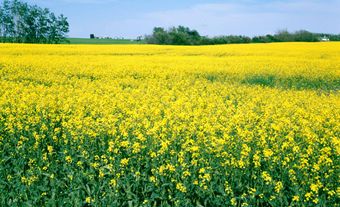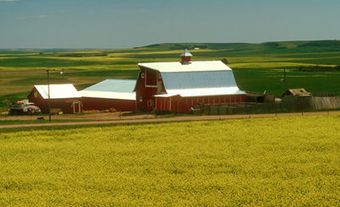Sunflower (genus Helianthus), common name for annual or perennial herbaceous plants native to the Western Hemisphere and belonging to the family Compositae. Some Indigenous groups grew a species of sunflower in North America, later brought to Europe by Spanish explorers. It evolved into an important crop (H. annuus var. macrocarpa) in Russia in the 18th century and was introduced to Canada in 1875. Modern cultivars (commercial varieties) are mainly single cross or three-way hybrids. Sunflowers grow 1.25-1.75 m tall and mature in 90-120 days. The more important or oilseed type has dark, thin-hulled seeds, with 40-50% oil content. The confectionery type has larger, lighter-coloured seeds, with thicker hulls and lower oil content. Sunflowers grow in soils ranging from sand to clay, but prefer well-drained soils. Intertillage and herbicides control weeds. Plant disease is controlled by resistant cultivars and rotations with crops not attacked by the several pathogens of sunflowers. Natural parasites, insecticides and cultural practices combat insect pests. The highly polyunsaturated oil, popular for cooking, is also used in margarine and mayonnaise. The high-protein meal remaining after the oil is extracted is formulated into livestock feeds. Confectionery seed is sold whole, roasted and salted, or dehulled. Significant Canadian seed production started with 2000 ha in 1943. Most plantings are of the oilseed type; over 90% of the sunflower seed crop comes from Manitoba, while Saskatchewan produces much of the balance. Plantings vary significantly from year to year.

 Share on Facebook
Share on Facebook Share on X
Share on X Share by Email
Share by Email Share on Google Classroom
Share on Google Classroom





